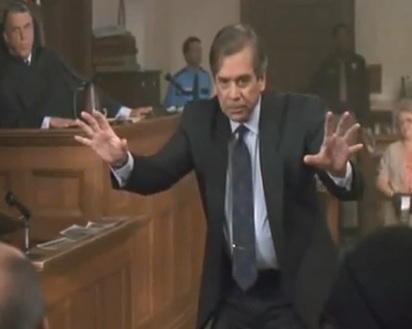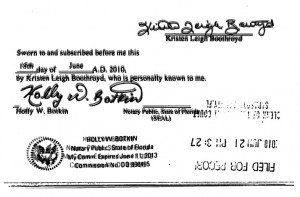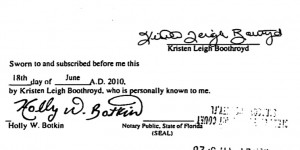This could be a problem…
Our good friends over at The Florida Foreclosure Fraud Weblog just uncovered some notary fraud on a massive scale…
Fraudulent Foreclosure Affidavits on a Massive Scale: The Gulf Coast Business Review
by Mike on July 7, 2010
In every foreclosure case, there are at least one, possibly two, points at which a legal notice must be published. In every foreclosure case, the notice of sale must be published in a local newspaper twice before the sale (Fla. Stat. § 45.031 (2)) and in some cases, if the owner of the property cannot be found, the plaintiff can serve by publication in the newspaper instead of having a process server deliver it personally.
But no matter what, any time a legal notice is published in a newspaper, some representative of the newspaper must provide a “Proof of Publication” affidavit, swearing that the ad was published on the dates indicated, and that the newspaper meets certain specified legal requirements.
In the Tampa Bay area, there is one newspaper that handles the legal notices for almost every foreclosure case: the Gulf Coast Business Review. And just last night, I had the opportunity to take a look at several of the “proof of publication” affidavits produced by that particular newspaper. You’ll be shocked at what I found.
Two things looked suspicious about the signatures on the affidavits. First, they were extremely uniform – almost identical. Second, the notary’s signature blocked out the signature line. Underneath the signature, instead of a line, there was just white space. These are classic signs of digital manipulation.
So I grabbed six different affidavits in a series of related foreclosure sales in Sarasota County. Once I had the digital images, I was able to copy the signature block by itself from each one, and digitally overlay them to see just how alike they were. One by one, the signatures shows themselves to be…

…identical. And you don’t need a 5710-A dual-column gas chromatograph with flame analyzation detectors to figure it out. You can just use your eyeballs. Here are two of the affidavits, one laid over the other (slightly offset so you can see both):

[click to enlarge]
Every letter on every affidavit, whether typed or signed, fell in exactly the same place on each sheet of paper – except the notary stamp. What does this mean? The affidavits aren’t affidavits at all – they’re computer-generated images that some foolish notary has been stamping her seal on. Knowing the volume of legal ads run by this paper, they’re probably generating hundreds of them for every issue.
And here’s the problem:
A notary public may not sign notarial certificates using a facsimile signature stamp unless the notary public has a physical disability that limits or prohibits his or her ability to make a written signature and unless the notary public has first submitted written notice to the Department of State with an exemplar of the facsimile signature stamp….
A notary public may not notarize a signature on a document if the person whose signature is being notarized is not in the presence of the notary public at the time the signature is notarized. Any notary public who violates this subsection is guilty of a civil infraction, punishable by penalty not exceeding $5,000, and such violation constitutes malfeasance and misfeasance in the conduct of official duties. It is no defense to the civil infraction specified in this subsection that the notary public acted without intent to defraud. A notary public who violates this subsection with the intent to defraud is guilty of violating s. 117.105.
Fla. Stat. § 117.107 (2) & (9) Mass-producing affidavit signatures like this, by computer, is flatly illegal. And if that’s what is really happening over at the Gulf Coast Business Review, this business is about to take a very interesting turn – for the worse. And for homeowners, it means one more chink in the armor, one more place to attack, one argument of last resort, before the sheriff comes to remove you from your home.
(Still doubting? Check out all six affidavits set one on top of another. The signatures line up, the letters line up, even the whitespace below the signature lines up – but the notary seals don’t.)
Thanks to notary Ron Gillis for teaching me more about Florida notaries than I ever thought I’d need.
For more info on issues like these see The Florida Foreclosure Fraud Weblog
~



II have Ronald Alonzo, Mary Jane Sarne, Bee Vang, Bobbi Irlas
You have listed a KASTRIOT NUNI – as a new robosigner 2015. I have his signature on a document of substitution of trustee. Can you provide me with any more details on Kastriot Nuni
Thanks
New Robo-signers 2015
Norma Gonzales
Andrew Bason
Connie L Borras
Michelle Nguyen
Ronald Alonzo
Theodore Shultz
Linda A Parks
Karla Sanchez
Irene Guerrero
Debra Dente
Mai Vu
Amanda Williams aka Amanda Welch
Yvette Greene
Kastriot Nuni
Shenesha McCray
Paige Shinn
Isabel P Cabrera
Danyell M Jackson
Christina Bitanga
Christian Aguilar
You have listed a KASTRIOT NUNI – as a new robosigner – he is on one of my documents – a substitution of Trustee – Can you provide any more info on this person. Thanks
I have an Appointment of Substitute Trustee with Yvette Greene of Chase Bank.
Robo-signing fraud is making a come back. The notaries are still in florida but the the foreclosure mills are on the West Coas now. McCarthy & Holthus are the David J Sterns of California. The crime ring consists of Quality Loans Services, ALAW fka, California ReConveyance Company, ID Solutions Inc., and Fidelity Title.